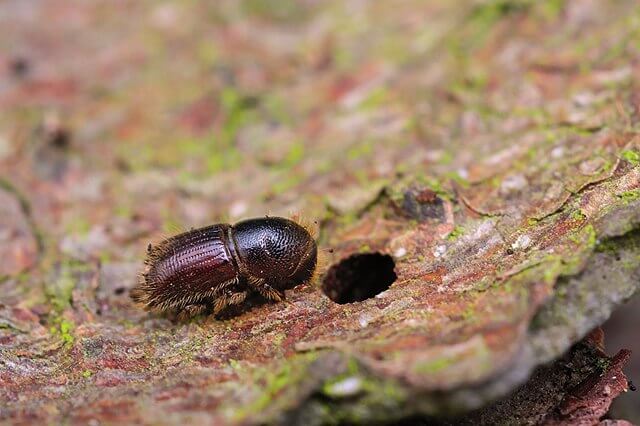
It is no bigger than a fingernail, yet this hairy beetle is one of the greatest threats facing Britain’s forests.
The spruce bark beetle has ravaged Europe’s woodlands, destroying millions of spruce trees. The UK government had hoped to prevent its arrival by inspecting imported wood at ports – but the insects were not hitching a ride in cargo. Instead, they were carried across the Channel on the wind.
Now government scientists are fighting back with an unusual toolkit that includes drones, sniffer dogs and even techniques borrowed from nuclear waste modelling. They say the beetle has been eradicated from high-risk areas in the east and south-east of England – though climate change could make the challenge far tougher in the years ahead.
The spruce bark beetle, Ips typographus, has been chewing its way through European conifers for decades. The insects feed and breed beneath the bark, creating intricate tunnel systems known as galleries. Healthy trees can resist small infestations by producing resin to flush the beetles out.
But in stressed trees, natural defences falter and beetle populations can explode.
“Their populations can build to a point where they can overcome the tree defences – there are millions, billions of beetles,” explained Dr Max Blake, head of tree health at the UK government’s Forest Research.
“There are so many the tree cannot deal with them, particularly when it is dry, they don’t have the resin pressure to flush the galleries.”
In Norway, where the beetle established itself more than a decade ago, it destroyed an estimated 100 million cubic metres of spruce, according to Rothamsted Research. With Sitka spruce the UK’s primary timber species, scientists such as Dr Chris Blake at Forest Research had long feared a similar disaster here.
“We have 725,000 hectares of spruce alone, if this beetle was allowed to get hold of that, the destructive potential means a vast amount of that is at risk,” said Andrea Deol at Forest Research. “We valued it – and it’s a partial valuation at £2.9bn per year in Great Britain.”
The risk is taken seriously: of more than 1,400 pests and diseases on the government’s plant health risk register. Ips typographus is considered “public enemy number one”.
The number of those diseases has been accelerating, according to Nick Phillips at charity The Woodland Trust.
“Predominantly, the reason for that is global trade, we’re importing wood products, trees for planting, which does sometimes bring ‘hitchhikers’ in terms of pests and disease,” he said.
Despite years of checks at the border, the beetle was discovered in woodland in Kent in 2018. A rapid-response effort was launched, deploying a mixture of techniques more akin to a military operation.
“We found a breeding population that had been there for a few years,” explained Ms Deol.
“Later we started to pick up larger volumes of beetles in [our] traps which seemed to suggest they were arriving by other means. All of the research we have done now has indicated they are being blown over from the continent on the wind,” she added.
“They are looking for a needle in a haystack, sometimes looking for single beetles – to get hold of the pioneer species before they are allowed to establish,” Andrea Deol said.
Drones now scan hundreds of hectares for signs of canopy dieback, while entomologists inspect trees on foot – covering 4,500 hectares of public forest in a single year, the equivalent of almost 7,000 football pitches.
The painstaking work has been bolstered by technology and canine assistance. Bark beetles emit distinctive pheromones to signal a suitable host tree, and produce frass (a mixture of insect waste and wood particles) with its own strong scent – both of which make them detectable by sniffer dogs. Early trials have proved highly effective, particularly in identifying beetles hidden in large timber stacks.
“We have [created] our own algorithm to identify the insects. We have taken about 20,000 images of Ips, other beetles and debris, which have been formally identified by entomologists, and fed it into the model,” said Dr Blake.
Cameras mounted on traps now provide daily scans, identifying beetles in real time in places that previously required weekly checks by ground teams.
As a result of these efforts, the UK has become the first country to eradicate Ips typographus in designated control zones which covers the south east and east England.
“What we are doing is having a positive impact and it is vital that we continue to maintain that effort, if we let our guard down we know we have got those incursion risks year on year,” said Ms Deol.
But the threat is far from over. Populations across Europe are surging, fuelled by climate stress. Wetter winters and milder temperatures leave trees waterlogged and weakened, while hotter, drier summers compound the strain. Storm damage then gives beetles the chance to gain a foothold.
With numbers rising abroad, the risk of new incursions carried on the wind increases.
“We have been doing modelling with colleagues at the University of Cambridge and the Met Office which have adapted a nuclear atmospheric dispersion model to Ips,” explained Dr Blake. “So, [the model] was originally used to look at nuclear fallout and where the winds take it, instead we are using the model to look at how far Ips goes.”
Nick Phillips of the Woodland Trust welcomed the government’s action but raised concerns about the fate of ancient woodland – the UK’s most ecologically rich forests. Commercial spruce plantations are often located beside these areas, and emergency clear-felling to contain infestations can put nearby ancient woodland under pressure.
“We really want the government to maintain as much of the trees as they can, particularly the ones that aren’t affected, and then also when the trees are removed, supporting landowners to take steps to restore what’s there,” he said. “So that they’re given grants, for example, to be able to recover the woodland sites.”
Although the government has increased funding for forestry, critics point out that support has largely focused on planting new trees rather than protecting the country’s most vulnerable and irreplaceable woodlands.
“If we only have funding and support for the first few years of a tree’s life, but not for those woodlands that are 100 or century years old, then we’re not going to be able to deliver nature recovery and capture carbon,” he said.
——————————————————————————
At Natural World Fund, we are passionate about restoring habitats in the UK to halt the decline in our wildlife.

